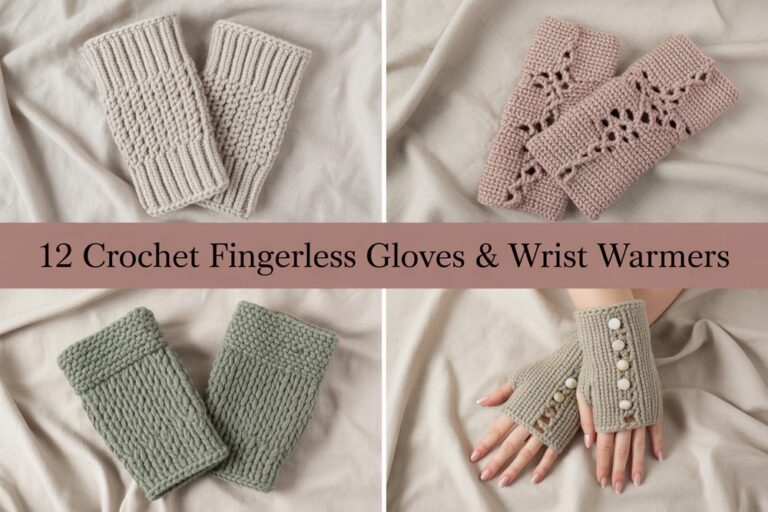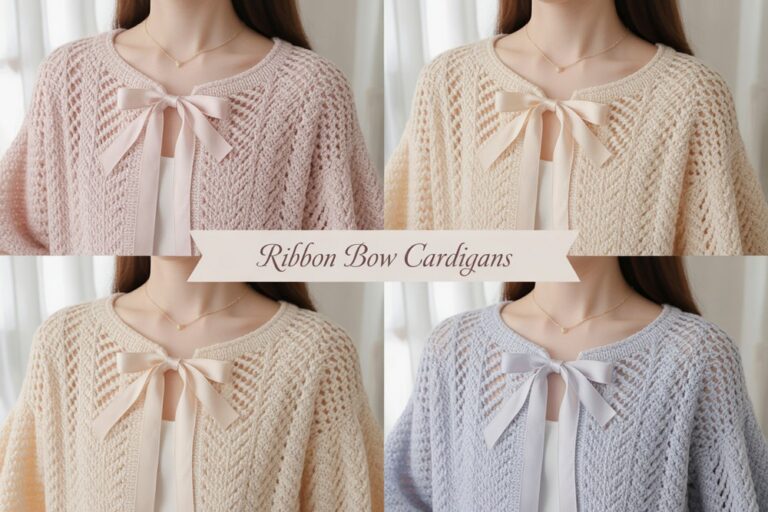10 Crochet Leg Warmers Aesthetic Ideas
Leg warmers are back—cozy, stylish, and wildly customizable. Below are ten looks that each bring a different vibe, from ballet-core to bold stripes to rugged, outdoorsy textures. I picked tutorials with clear photos and step-by-step instructions so you can match colors and finishes exactly. You’ll find options for adults and kids, skinny fits and slouchy styles, chunky yarns and sleek ribbing. Skim the aesthetics, pick the one that suits your wardrobe, grab the listed supplies, and you’ll have a pair ready for dance class, lounging, or layering with boots.
Barbie-Core Ribbed Slouch

Turn up the 80s energy with ribbed slouch leg warmers in punchy pink-and-white stripes. This easy, tube-style design works in rounds with simple stitches that create cushy ribbing and lots of scrunch. Size by measuring around your calf and following the pattern’s XS–M guidance; plan about 300–400 yds of worsted acrylic for adult sizes. Tip: keep your tension even on the rib rows so they stay stretchy but not loose. Make a second pair in a neutral for everyday wear—see the tutorial for stitch placement and sizing. Tutorial.
Supplies:
- Worsted acrylic (#4) (Red Heart Super Saver)
- Hook 5.5 mm (I-9)
- Yarn needle, scissors, tape measure
Why it’s great: Loud color + soft ribbing = instant statement layer for leggings and sneakers.
Thigh-High Self-Striping Pop

Go bold with thigh-high warmers worked in self-striping sock yarn. The lightweight fabric hugs without bulk, and the gradual color changes do all the styling for you. The pattern includes multiple sizes; one skein per leg is a good target—check the listing for Heart & Sole yardage. Tip: steam-block lightly to smooth any laddering from color changes. Wear them over tights with boots or scrunch them to knee height for daily wear. Full instructions and the “Tequila Sunrise” palette are in the tutorial. Tutorial.
Supplies:
- Fingering self-striping (#1) (Red Heart Heart & Sole)
- Hook 3.5–4.0 mm (E/4–G/6)
- Thin elastic (optional), yarn needle
Why it’s great: Eye-catching stripes with a sleek fit that layers under tall boots.
Lavender Ballet Basics

Soft, simple, and dance-class ready, these kids’ warmers start with a ribbed cuff and build upward in easy rounds. Sizes S–L cover toddlers to grade-schoolers; plan one ball of soft acrylic for most sizes. Add ribbon if you like a ballet finish. Tip: measure over tights for the best fit, and keep ribbing snug so they stay put through stretches and spins. The tutorial page includes the Lavender shade call-out and downloadable pattern for quick reference. Tutorial.
Supplies:
- Worsted acrylic (#4) (Red Heart Soft)
- Hook 4.0 mm (G/6)
- Ribbon (optional), yarn needle, scissors
Why it’s great: Clean, classic look that pairs with leotards, skirts, or joggers.
Raspberry Scallops

These sweet toddler warmers feature a simple tube body with scalloped trim at both ends for a dressed-up finish. They’re quick, adjustable, and adorable over leggings or leotards. One skein of Vanna’s Choice in Raspberry is plenty for the pair. Tip: block the scallops lightly so they lay flat and stay crisp. Make them longer by adding repeats in the middle section; they scale easily for bigger kids, too—details are in the post. Tutorial.
Supplies:
- Worsted acrylic (#4) (Vanna’s Choice, Raspberry)
- Hook 5.0 mm (H/8)
- Measuring tape, yarn needle
Why it’s great: Fast gift with a standout scallop edge.
Neutral Cable Chic

If you love texture, try these cable-rich warmers with ribbed cuffs. They’re worked in the round with post stitches for bold, columned cables. A heathered neutral like Heartland “Katmai” delivers that luxe, goes-with-everything look. Expect 1–2 skeins depending on length. Tip: keep your cable count consistent and mark rounds—cables look best when aligned. The blog post has detailed step-by-step photos and notes on finishing the cuffs cleanly. Tutorial.
Supplies:
- Worsted acrylic (#4) (Lion Brand Heartland, Katmai)
- Hook 4.5 mm
- Stitch markers, yarn needle, tape measure
Why it’s great: Sophisticated texture that elevates jeans and boots.
Oatmeal One-Skein Slouch

This beginner-friendly pair uses one skein of natural wool and a simple texture sequence for a cozy, slightly slouchy fit. It’s worked in the round with easy post-rib trims. Target ~465 yds of Fisherman’s Wool in Oatmeal for an adult pair. Tip: try on mid-make and add repeats if you want extra scrunch. There’s also a linked video to help with stitch placement—handy if you’re newer to garments. Tutorial.
Supplies:
- Worsted wool (#4) (Fisherman’s Wool, Oatmeal)
- Hook 5.0 mm
- Yarn needle, scissors, markers
Why it’s great: Neutral, natural fiber warmth that dresses up or down.
Peppermint Stripes Holiday

Candy-cane stripes make these a festive go-to. You’ll alternate red and cream bands with third-loop hdc for stretch and add ribbing at the top edge. The pattern offers fit options (straight, tapered, or wide), so you can tailor them to your calves. Yardage: ~200–300 yds red, ~150–250 yds cream. Tip: carry the unused color up the inside to reduce ends. Full sizing and technique notes are in the tutorial. Tutorial.
Supplies:
- Worsted acrylic (#4) (red + cream)
- Hook 5.0 mm (H/8)
- Yarn needle, measuring tape
Why it’s great: Bold, cheerful stripes with a comfy stretch fit.
Gradient Ankle Warmers

Short and sweet, these ankle warmers use a DK gradient to show off color shifts without bulk. The stitch pattern alternates single crochet and clusters for a nubbly look that traps warmth around the ankles. Plan ~150–200 yds of DK. Tip: choose a gradient that echoes your slippers or lounge set, then match the starting color on both warmers for symmetry. The post includes in-progress pictures and clear step photos. Tutorial.
Supplies:
- DK acrylic or wool blend (#3) (gradient)
- Hook 3.0 mm
- Yarn needle, scissors
Why it’s great: Fast, comfy layer that pairs perfectly with slippers.
Snow-Flurry Chunky Poms

Chunky, ribbed, and unbelievably soft, these are worked flat in back-loop single crochet, then seamed. The Homespun texture looks plush in creamy white, and pom-poms add a playful touch. Yardage: one skein is often enough for kids; plan more for adult lengths. Tip: measure the rectangle on the leg before seaming—Homespun stretches, so err a little smaller. The blog tutorial shows the back-loop technique clearly and how to place poms. Tutorial.
Supplies:
- Bulky acrylic (#5/6) (Lion Brand Homespun “Mimosa”)
- Hook 6.0 mm (J/10)
- Pom-pom maker, needle, tape measure
Why it’s great: Plush winter vibes that sew up fast and fit any size.
Boston Texture Warmers

Clean, modern texture built from simple (sc, hdc, sc) clusters gives these tubes a refined, athletic look. Written in one size with easy instructions to adjust width and length; plan ~510 yds of worsted. Try Lion Brand Heartland for soft, heathered colorways. Tip: make both legs to identical row counts so the texture pattern aligns. The tutorial includes gauge notes, stitch glossary, and round-by-round directions. Tutorial.
Supplies:
- Worsted acrylic (#4) (Heartland)
- Hook 5.0 mm (H/8)
- Scissors, needle, measuring tape
Why it’s great: Everyday wearable texture that slips under boots or scrunches over leggings.
Conclusion
Pick one that matches your wardrobe and yarn stash, then measure, swatch, and go. Leg warmers are quick, relaxing makes that deliver instant coziness and style—great for gifts or for freshening up your own outfits. Bookmark this list so you can circle back for a second pair in a new colorway. Happy hooking and happy layering!
FAQs
What yarns work best for leg warmers?
Acrylic and wool blends are great for warmth and memory. Choose light yarns (fingering/DK) for sleek fits and heavier yarns (worsted/chunky) for plush slouch.
Machine wash or hand wash?
Check the label. Acrylics are usually machine-washable, cold and gentle; lay flat to dry. Wool blends often prefer hand wash and flat dry to prevent stretching.
How do I scale a pattern?
Measure the widest part of your calf over what you’ll wear (tights/jeans). Adjust starting stitch count or rows to match that circumference, then add or subtract length repeats.
Which fibers are safe for kitchen/bath or heat exposure?
For everyday warmth, acrylic and superwash wool are fine. Avoid high heat (radiators/heaters); never rely on acrylic near hot surfaces as it can soften.
Best joins/edgings for durability?
Use slip-stitch joins and sturdy ribbing (post stitches or back-loop rib). Reinforce ends by weaving in for at least 4–6 cm with direction changes.
Typical time and yardage?
Ankles: 1–3 hours, ~150–200 yds (DK). Mid-calf: 3–6 hours, ~300–500 yds (worsted). Thigh-high: 6–10 hours, ~600–800 yds (fingering/sport).
How do I photograph finished projects?
Use natural window light, a neutral wall or floor, and frame from knee to ankle. Shoot at a low angle to show texture and keep colors true.
Fixing curling, stretching, or wavy edges?
Curling: block lightly or add a ribbed cuff. Stretching: go down a hook size or add elastic thread inside the cuff. Wavy edges: check stitch counts and ease; steam-block flat.







